Tips for Quality Run Training Train no faster than one pace quicker than the race you are training for. For example, 5k pace is good for an Olympic-distance race, while half-marathon pace suffices...
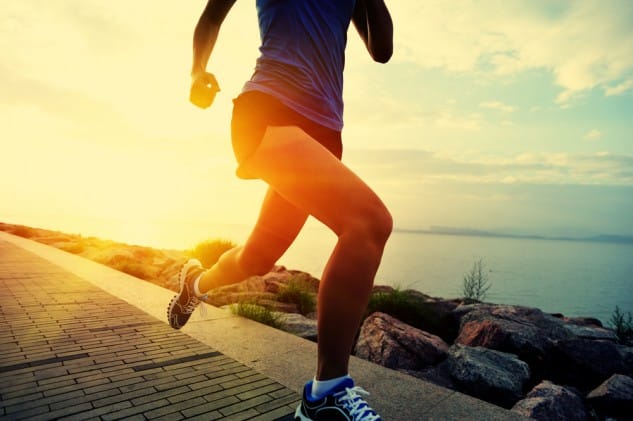

Tips for Quality Run Training Train no faster than one pace quicker than the race you are training for. For example, 5k pace is good for an Olympic-distance race, while half-marathon pace suffices...

Being immersed in the fitness industry provides me with a ton of different opportunities to experience different techniques, methodologies, and products. I recently had the privilege of a...
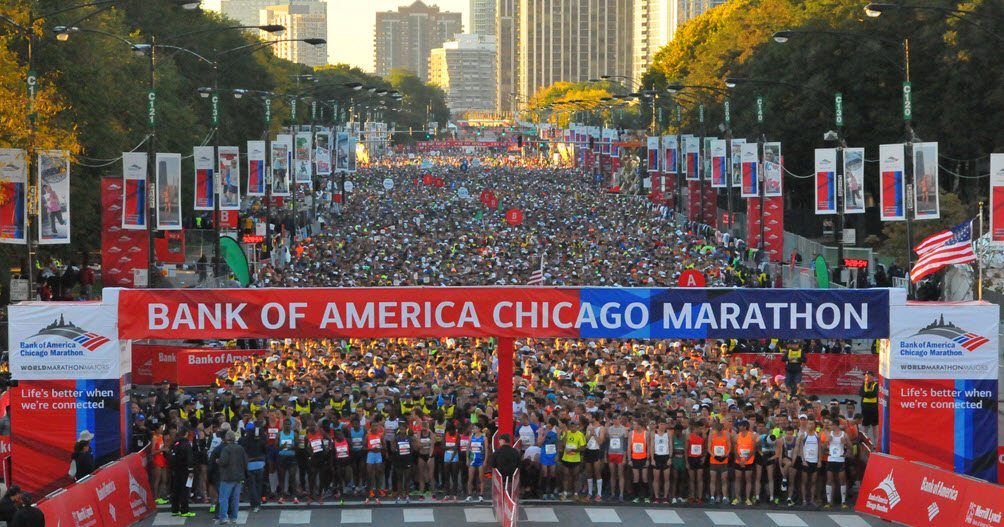
Leading up to the Chicago Marathon 2016 The Chicago Marathon provides an excellent course, plenty of support and, for me, a chance to visit home for a few days. It was no different for me this...

September 25 was going to be my day. The Ironman Augusta 70.3 triathlon was finally here. The race I had been training so hard for on one of my favorite courses. It was four-and-a-half months...
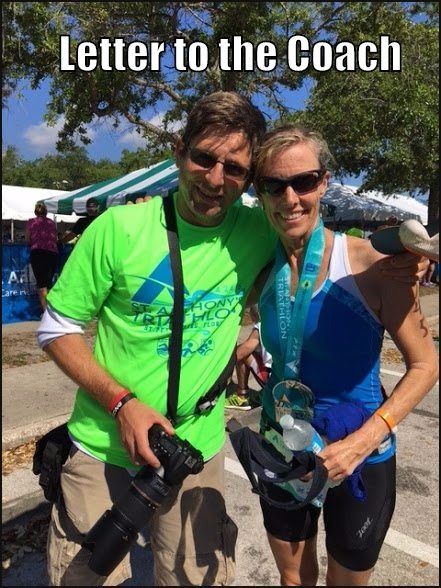
I have been an endurance coach for some time now. Once in a while, I receive an email from a client which chokes me up with pride. Today, I received one of those letters, so instead of sharing it...
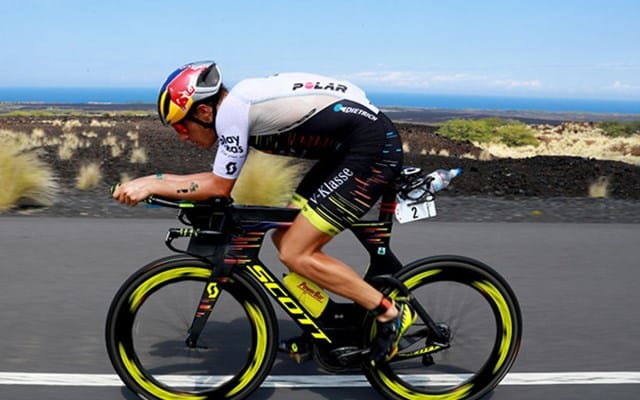
I found when looking for ways to get faster on the bike, is that there is so much information, from different coaches and experts, that it can be confusing and overwhelming. Personally, I...
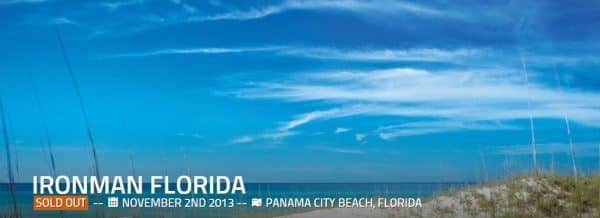
For a long time, it has been called the Granddaddy of all endurance events, the Ironman triathlon. A 2.4-mile swim, 112-mile bike and a 26.2-mile run done consecutively in the same day. Of course, nowadays, double, triple, and even deca Ironman distance triathlons are becoming more and more popular, as well as 24, 48 and even 72-hour mud and obstacle run challenges. If you are calling me crazy for doing my second Ironman, I can introduce you to at least a few people who do challenges that make Ironman look like a game of hopscotch. (Yes, Matt “UltraIronBeast” Dolitsky, you are one of those.)
This competition for me was a learning experience in overcoming obstacles, most of them mental. I did not PR, or even come close, but I now understand completely the quote, “The mind will quite 100 times before the body does.”
Pre-Race

Pete Amedure, Kari Eichen, Kat Ward, Jamie Breibart and myself all decided to drive up Wednesday morning in order to get acclimated to the environment and eliminate and reasons for not being prepared for Saturday’s race. Pete, Kari and I were in my car and had a great time on the way up. Of course, there was a stop at the Huddle House in Perry Florida where we ate and laughed to a point where I spaced out and left my phone, and didn’t realize it until we were half-an-hour from Panama City Beach. It didn’t help that I was in the middle of contracts and had all my recruiters contacting me about interviews and new opportunities. (I ended up remedying this by sending FedEx to the restaurant and delivering it to our hotel. In the meantime, Google Voice was a tremendous help.)
We arrived at the Laketown Wharf complex where we stayed in a luxurious three bedroom, three bath condominium, with a beautiful view of the gulf. I give this hotel/condo complex four stars. It had everything needed including a nightly water and light show that rivals the Bellagio in Las Vegas. Well, not really, but it was a fun amenity. The condos all have a full kitchen, with dishes, glasses, silverware, pots and pans, coffee maker, and a full-size refrigerator. Everything needed for the athlete, and spectathletes, to remove all those pressures of nutrition, and early morning breakfasts. The area also has plenty of great restaurants for good eating as well.
Afterward, we walked the quarter mile to athlete check-in to receive our chip, bibs, bags, and swag. I was a little disappointed in the swag this year. Last year they gave out beautiful TYR transition backpacks, but this year it was a very inferior white backpack that looks like it will fall apart. Jamie’s actually did, so they gave her a replacement immediately. The expo was about twice the size that it was last year, with a host of new vendors. Verizon was displaying their goods, as they were the tracking sponsor this year, along with Newton, Fit2Run, a local bike shop and a bunch of the regulars. Refuel was there, talking about Chocolate Milk, so I did create a video with them talking about the benefits of it. I will share that link on Twitter when I receive it. It should be good for a couple of laughs.
After that, we spent the next couple of days, taking in the aura of Ironman, preparing and eating. Eating was a non-stop event for us. I knew from experience that immense calories were going to be needed in order to be comfortable on the course, so I encouraged our team to keep eating as I did myself.
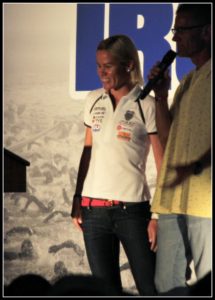 Thursday night was the athlete welcome dinner, and I was almost embarrassed. My recollection of the 2011 athlete dinner was so wonderful, that I really talked it up and encouraged Pete, Jamie, and Kari to come. Jamie decided not to go, but I was so excited for Pete and Kari to be there I couldn’t contain my emotions. Unfortunately, I was sort of let down. It seemed unorganized and hurried. Yes, my favorite pro-triathlete and world champion Mirinda Carfrae was interviewed on stage, so that was great, but the rest of it was about charities and a couple of athletes overcoming their own obstacles. There were video presentations about a woman who was competing for her husband who died the year earlier while training, and a quadriplegic who was competing to show the world that anyone could do anything if they just challenged themselves.
Thursday night was the athlete welcome dinner, and I was almost embarrassed. My recollection of the 2011 athlete dinner was so wonderful, that I really talked it up and encouraged Pete, Jamie, and Kari to come. Jamie decided not to go, but I was so excited for Pete and Kari to be there I couldn’t contain my emotions. Unfortunately, I was sort of let down. It seemed unorganized and hurried. Yes, my favorite pro-triathlete and world champion Mirinda Carfrae was interviewed on stage, so that was great, but the rest of it was about charities and a couple of athletes overcoming their own obstacles. There were video presentations about a woman who was competing for her husband who died the year earlier while training, and a quadriplegic who was competing to show the world that anyone could do anything if they just challenged themselves.
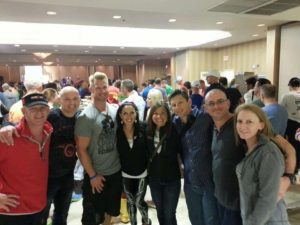 Yes, their stories were inspiring but I just felt like it was too much and way too long. In 2011 the presentations were balanced between the negative and the positive inspiring stories and we even had an athlete briefing by the race director all in the span of 90 minutes. It held the attention of every athlete to a point where the announcer almost didn’t need the microphone. This time, a good portion of the athletes conversed right through all the presentations to a point where it was hard to hear the MC with a microphone. I felt like I let my friend Pete down to a point where I was apologizing so much on the walk back I became annoying. Sorry, Pete and Kari.
Yes, their stories were inspiring but I just felt like it was too much and way too long. In 2011 the presentations were balanced between the negative and the positive inspiring stories and we even had an athlete briefing by the race director all in the span of 90 minutes. It held the attention of every athlete to a point where the announcer almost didn’t need the microphone. This time, a good portion of the athletes conversed right through all the presentations to a point where it was hard to hear the MC with a microphone. I felt like I let my friend Pete down to a point where I was apologizing so much on the walk back I became annoying. Sorry, Pete and Kari.
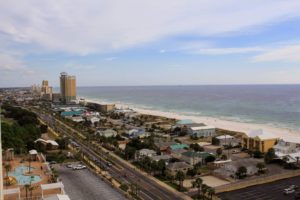 Friday, the anxiety hit like a ton of bricks. You couldn’t cut the tension in the condo with a Ginsu, serrated edge knife. We ate breakfast and then headed down to the beach to get in the water with our wetsuits. The waves sets were barreling to the shore with such force that the red, “no-swimming”, flag was flown, but we knew we needed to at least get in the water for a few minutes just to test out our goggles and our wetsuits. Surprising enough, even with the force of the waves, I thought I became a little more confident. I was able to stay on the surface of the water, and I practiced duck diving through the waves instead of trying to swim over them. I really thought I may have a chance of being faster out of the water than I thought.
Friday, the anxiety hit like a ton of bricks. You couldn’t cut the tension in the condo with a Ginsu, serrated edge knife. We ate breakfast and then headed down to the beach to get in the water with our wetsuits. The waves sets were barreling to the shore with such force that the red, “no-swimming”, flag was flown, but we knew we needed to at least get in the water for a few minutes just to test out our goggles and our wetsuits. Surprising enough, even with the force of the waves, I thought I became a little more confident. I was able to stay on the surface of the water, and I practiced duck diving through the waves instead of trying to swim over them. I really thought I may have a chance of being faster out of the water than I thought.
Afterward, we talked through our transition plans to double check our gear,  checked to make sure our bikes were ready to go and proceeded to transition to check-in everything. We had decided to try and wait out the rain, but unfortunately, I had a phone interview which had the chance of exceeding beyond the time check-in would close, so we walked down in the rain. The line was so long, I was going to be cutting it very close, so afterward, I ran back to the hotel. On the way back, I dropped my phone and cracked the screen. Yes, I had the phone back in my hands all of two hours and I dropped it. I have never broken a phone before, ever, and here I had two phone interviews and I cracked the screen. I was lucky enough that the phone still worked with voice recognition and a little effort, so the two interviews scheduled went off without any problems and I confirmed them both for second interviews as well.
checked to make sure our bikes were ready to go and proceeded to transition to check-in everything. We had decided to try and wait out the rain, but unfortunately, I had a phone interview which had the chance of exceeding beyond the time check-in would close, so we walked down in the rain. The line was so long, I was going to be cutting it very close, so afterward, I ran back to the hotel. On the way back, I dropped my phone and cracked the screen. Yes, I had the phone back in my hands all of two hours and I dropped it. I have never broken a phone before, ever, and here I had two phone interviews and I cracked the screen. I was lucky enough that the phone still worked with voice recognition and a little effort, so the two interviews scheduled went off without any problems and I confirmed them both for second interviews as well.
That night we had a good dinner at the Wicked Wheel and we were all in bed around 9 pm ready to take on the Ironman.
Race Day
As predicted, the night before was restless but I did end up sleeping a good 4-5 hours before the alarm went off. As planned we dressed in sweats, grabbed our “Special Needs” bags, nutrition for the bike, and headed to transition around 4:30 am. We were body marked, checked our bikes, dropped our bags, and then headed back to try and leisurely eat breakfast, and dress for the race. Kari cooked eggs and turkey bacon, I cooked oatmeal and we all hung out for a while and tried to prepare ourselves with our loved ones. It was kind of surreal. I remembered these moments from the first time I competed in this race, but it still seemed like it was all new again.
We dressed, pulled on our wetsuits halfway, hugged and headed for the start line. We walked  with Kari, Kim, and Danny down to the start, but athletes had to enter separately than spectators, so when we finally hit the beach we couldn’t find them. I really wanted to see them all before the start, but I knew I would be ok if I didn’t, but Kari had Pete’s goggles in her bag, so now it became imperative that we find them. We walked over trying to find them, so when it came to a point where we had no time left, we dropped our stuff and proceeded to button up our wetsuits and prepare to go under the arch. It was at that moment, our party found us. Talk about cutting it close. We hugged, gut our well wishes, wished each other luck and headed into the mass of athletes preparing for the start.
with Kari, Kim, and Danny down to the start, but athletes had to enter separately than spectators, so when we finally hit the beach we couldn’t find them. I really wanted to see them all before the start, but I knew I would be ok if I didn’t, but Kari had Pete’s goggles in her bag, so now it became imperative that we find them. We walked over trying to find them, so when it came to a point where we had no time left, we dropped our stuff and proceeded to button up our wetsuits and prepare to go under the arch. It was at that moment, our party found us. Talk about cutting it close. We hugged, gut our well wishes, wished each other luck and headed into the mass of athletes preparing for the start.
This year was a little different as signs were being held up with expected times for the swim. It could be compared to pace groups commonly found in road races except instead of going deep from a start line this went wide along the shore with the idea that if the slower swimmers would be the widest from the buoys and would fall in behind the faster ones. This was thought to bring down the chaos of a mass swim start, but for me, it was worse. I have been in comparable rough water, hit, kicked and swam over before and I always kept on swimming no matter what, but this time I was kicked so many times with the last time throwing my goggles from my face. It took me a few minutes to find them floating away from me, but I was able to put them back without too much trouble.
When I finished my first loop, the clock said 1:11 which was very slow. I thought I should be able to make up at least three minutes on the second loop, so I shouldn’t be in any danger of not making the 2:20 cutoff. I found a rhythm and just kept swimming, but I veered to the left of buoys and to keep correcting my course. When I made the turn for the straightaway to the swim finish, I glanced at my wrist to check my Garmin to see how much time I had left, and it was gone. Not only could I not find out what I needed to cross the swim finish, I wasn’t going to know how fast I would bike, or run. I wouldn’t know when to take my nutrition or even what time it was.
 Three buoys from the end I ended up with a paddle boarder on the left of me and jet ski on the right. The paddleboarder kept yelling the time I had left. “You have 8 minutes. You got this just keep going.” I have to admit, the idea of a DNF crossed my mind and it did not scare me. I thought to myself “would it really be the end o the world.” I would be able to support Pete, Jamie, and Kat and I wouldn’t have to worry about biking 112 miles, chafing, nutrition, none of it. Of course, I wouldn’t get to cross that finish line and I would feel like a failure and that is what really scared me. It wasn’t the disappointment of my friends or even my family, it was the disappointment I would have in myself. That never-ending coulda, woulda, shoulda would really haunt me, so I sped up and went as hard as I could. The waves after the sandbar helped and even though I got caught up in the rope tied to one of the lifeguard’s flotation device I was able to hit the beach at exactly 2:20 getting me over the timing mat at 2:20:08.
Three buoys from the end I ended up with a paddle boarder on the left of me and jet ski on the right. The paddleboarder kept yelling the time I had left. “You have 8 minutes. You got this just keep going.” I have to admit, the idea of a DNF crossed my mind and it did not scare me. I thought to myself “would it really be the end o the world.” I would be able to support Pete, Jamie, and Kat and I wouldn’t have to worry about biking 112 miles, chafing, nutrition, none of it. Of course, I wouldn’t get to cross that finish line and I would feel like a failure and that is what really scared me. It wasn’t the disappointment of my friends or even my family, it was the disappointment I would have in myself. That never-ending coulda, woulda, shoulda would really haunt me, so I sped up and went as hard as I could. The waves after the sandbar helped and even though I got caught up in the rope tied to one of the lifeguard’s flotation device I was able to hit the beach at exactly 2:20 getting me over the timing mat at 2:20:08.
I don’t mind stating that I was exhausted. I have stated it time and time again, that I am not even a good swimmer, but this really put it in perspective.
I ran into transition and the volunteers stated I had eight minutes to cross the bike mat, so they hurried me into my bib and jersey I was using for the bike, put on my helmet and shoes and rushed me out into transition to grab my bike. I crossed and headed out on my 112-mile journey.
My lungs were screaming and my stomach was churning, but I just kept going. I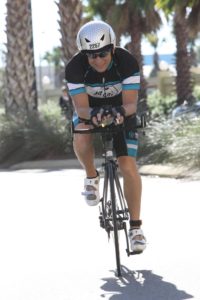 passed the mile 10 marker and about, what I estimate was around the 12-13 mile mark, nausea started. I pulled over to the side of the road and vomited sea water over the guardrail. Unfortunately, I have what is called a vasovagal response to vomiting, which basically means I pass out cold. I woke up, splayed out on the side of the road with the sun shining in my eyes. It took a while to get my wits and balance in order to get back on my bike. I continued slowly with the thoughts of turning around and just ending it. Who would blame me? I became sick on the bike, no one would care. With my stomach still churning and my head spinning I decided I would go to the twenty-mile marker and if I didn’t feel better I would turn around. The earlier thoughts I had of a DNF plagued me again and when I saw the 20-mile sign, I was still feeling sick, but better than I did. I took in some of the Isagenix mix I had in my bottles and decided to go on to the next marker, but it wasn’t more than a mile later I realized that if I turned around at the 30 mile mark, I would have biked 60 miles by the time I got back to the start. That’s when I knew I had it in me. It no longer was about time now it was about finishing.
passed the mile 10 marker and about, what I estimate was around the 12-13 mile mark, nausea started. I pulled over to the side of the road and vomited sea water over the guardrail. Unfortunately, I have what is called a vasovagal response to vomiting, which basically means I pass out cold. I woke up, splayed out on the side of the road with the sun shining in my eyes. It took a while to get my wits and balance in order to get back on my bike. I continued slowly with the thoughts of turning around and just ending it. Who would blame me? I became sick on the bike, no one would care. With my stomach still churning and my head spinning I decided I would go to the twenty-mile marker and if I didn’t feel better I would turn around. The earlier thoughts I had of a DNF plagued me again and when I saw the 20-mile sign, I was still feeling sick, but better than I did. I took in some of the Isagenix mix I had in my bottles and decided to go on to the next marker, but it wasn’t more than a mile later I realized that if I turned around at the 30 mile mark, I would have biked 60 miles by the time I got back to the start. That’s when I knew I had it in me. It no longer was about time now it was about finishing.
From that point on the bike ended up being uneventful. Sure, there were minor challenges. For instance, the wind picked up quite a bit, and of course, I still had no perception of time, except for when I asked, but I just put my head down and kept going.
Here is a little lesson learned while I was on the bike. As I mentioned the wind became a challenge during the bike, but I decided to wear an aero helmet and while I was in aero position and looked down, the wind became a little less a factor. I found myself being able to pick up a higher cadence. The minute I looked straight I could not only hear the wind, but I felt like someone had hit the breaks on my bike. Every article and person always said, one way and the cheapest way to become more aero was a helmet. They were right.
Being the last one out of the water did have one advantage. I wasn’t going to get passed. I was doing all the passing, and with each rider I passed, I felt a little bit of mental boost which helped a great deal. I rolled into transition in a little over 7 hours, which, in my estimation, had me on the side of the road for a little over 30 minutes. All-in-all it wasn’t actually that bad.
A volunteer grabbed my bike, I snatched my run gear bag and was greeted in the changing room by my friend, and client, Hugo Scavino. He helped me rid myself of the bib and bike jersey and don my shoes and hat. After a huge hug, I headed off onto the run course. I stopped briefly for words of encouragement, hugs and kisses from Kim, Kari, Maria and Anne, and off onto the course I went. I walked for about a quarter mile before I started running. I was kind of amazed. I felt like I was able to transition to my running legs a little easier than the Augusta 70.3 I competed in six weeks earlier. I hit the first aid station in about 1.5 miles and I was feeling pretty good. I formulated my plan of running from aid station to aid station and just walking while I was getting water and nutrition. This worked for the first loop.
 Pete and Jaime passed me at my mile 3 and their mile 10 and we shook hands and I motivated Pete with warning him I should not be able to catch him. Of course in the back of my mind, I was questioning if I could somehow make up 7 miles on him. Dave Nardoski caught up with me on his second loop, so I walked and chatted with him for a few minutes before I picked up the pace again. At mile 6 I saw Kat looking really strong and I yelled some encouragement to her as I passed. The halfway point for the first loop is in a park and I was feeling pretty good. I started doing the math in my head for what it would take to catch up to Pete and Jamie. The idea of the three of crossing together seemed surreal but possibly realistic. At mile 10 I saw Jamie and she had picked up the pace from Pete, and she looked really good. Obviously, the three of us crossing was most likely not going to happen unless I could really pick up some speed and Pete and I could catch her. A little while later I saw Pete again walking. We stopped for a minute and he told me that everything hurt. I gave him some encouragement and we parted. Just prior to the turnaround I found myself running next to Lew Hollander. Lew, is an 83-year-old, twenty-time Kona qualifier and finisher. He is extremely inspiring and is the epitome of the idea that age doesn’t have to be an excuse. We chatted briefly, he gave me some motivation, I congratulated him, he ran into the finisher chute and I made the turn. Kim and Danny were on the other side of the turn, so I was able to see them and get some love and hugs from Kim. She actually ran a little bit with me before I headed off.
Pete and Jaime passed me at my mile 3 and their mile 10 and we shook hands and I motivated Pete with warning him I should not be able to catch him. Of course in the back of my mind, I was questioning if I could somehow make up 7 miles on him. Dave Nardoski caught up with me on his second loop, so I walked and chatted with him for a few minutes before I picked up the pace again. At mile 6 I saw Kat looking really strong and I yelled some encouragement to her as I passed. The halfway point for the first loop is in a park and I was feeling pretty good. I started doing the math in my head for what it would take to catch up to Pete and Jamie. The idea of the three of crossing together seemed surreal but possibly realistic. At mile 10 I saw Jamie and she had picked up the pace from Pete, and she looked really good. Obviously, the three of us crossing was most likely not going to happen unless I could really pick up some speed and Pete and I could catch her. A little while later I saw Pete again walking. We stopped for a minute and he told me that everything hurt. I gave him some encouragement and we parted. Just prior to the turnaround I found myself running next to Lew Hollander. Lew, is an 83-year-old, twenty-time Kona qualifier and finisher. He is extremely inspiring and is the epitome of the idea that age doesn’t have to be an excuse. We chatted briefly, he gave me some motivation, I congratulated him, he ran into the finisher chute and I made the turn. Kim and Danny were on the other side of the turn, so I was able to see them and get some love and hugs from Kim. She actually ran a little bit with me before I headed off.
I was hurting now. At mile 14 I slowed to a walk. My feet were screaming in agony, my hips, quads, hamstrings and IT bands were in a lot of pain and I started getting a twinge in my back. I didn’t want to walk, but my legs were not letting me run either. I decided I would walk to the aid station of after mile 15 and continue from there. It didn’t happen the way I wanted. I ended up doing a series of run/walk intervals all the way to mile 18 where Pete and I crossed for the last time. We high-fived each other and continued on. Not too far ahead I stopped to use a portlet, but when I exited I became turned around and stupidly started running in the wrong direction. I caught myself about a half mile before I realized what I was doing and quickly did a one-eighty. I guess I was meant to run even more than a marathon this time.
I did meet Susan, a member of the Sarasota Storm Tri Club, which I have participated in races and training with. We chatted and played cat and mouse for a while. Susan had a very steady pace, so I would catch her and then when I would walk she would pass me. This happened about 3 or 4 times throughout the marathon portion. After getting completing the out-and-back in the park to head to the finish I started to feel like I just was about done with this whole thing. I was walking more than running, I was in pain and I was just ready for this experience to end. When I saw mile 20, I thought I only have a 10k left. I could do a 10k in my sleep. I started to pick up the pace just a bit. I walked through the aid station in between 20 and 21 and started talking to myself. “C’mon legs. Just one more training run. I need ya. Relax. Use gravity as momentum. We can do this.”
Ahead was mile marker 21, and it was then when I decided, there will be no more stops at aid stations, there will be no more walking. It was time to get this done. I picked up the pace and never looked back. I caught up with Susan at mile 22 and I told her to come with me. This was just a 5k with a one-mile warm-up. She said something that really motivated me. “You are really strong, Brad.” Who was she trying to kid? It wasn’t 12 hours ago I had thoughts of quitting. I didn’t quit though and here I was 4 miles from the finish of my second Ironman. I picked up the pace even more to a point where I was running at a sub 8:30 pace for a bit. I was in a lot of pain, but it was going to be worse if I stopped. Every time I passed another athlete or spectator they would say “Good job” and that just fueled me. A couple of the spectators would yell, “Awesome pace keep it up!” I ran through the Tri Club village at 25 when someone yelled “Go Goof GO!”, so I even picked up the pace even more. When I finally reached the chute there were two people running together in front of me and I didn’t know whether to let them go ahead or pass them. I passed them and sped up even more in order to make sure I was alone at the finish line.
I saw the finish line and didn’t even look at the clock. After all, I hadn’t known what time it was up to that point, so what did it matter now. The announcer bellowed, “Brad Minus from Tampa Bay, YOU ARE AN IRONMAN!” Oh, how sweet that sounded. Especially after being kicked, and hit in the water, losing my goggles and Garmin, vomiting and blacking out on the side of the road, and running through all that pain. I finally reached the finish.
A volunteer escorted me to Yvonne Van Vlerken, the women’s first-place finisher, who placed the medal around my neck. We congratulated each other and she gave me a hug, and then I continued with my handler to get a shiny warming sheath, and a finish photo before she handed me off to Kim, Maria, Jamie and the Dannys. I saw Pete sitting down and we just looked at each other with pain on our faces but pride in our eyes.
The rest of the night consisted of pizza and hard cider and regaling stories of the race. PB&J had accomplished what we set out to do a year earlier.
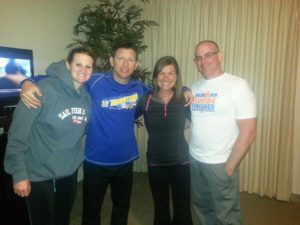 Jamie was the heroine of the night. When she decided to run she end up fast enough to finish with a 13:50. I am still so proud of her. Pete ended up a little under 15 and I ended up with a 15:09. I am not happy with it. It is significantly longer than 2011, but I finished and everything considered, I did have fun. That is what matters most.
Jamie was the heroine of the night. When she decided to run she end up fast enough to finish with a 13:50. I am still so proud of her. Pete ended up a little under 15 and I ended up with a 15:09. I am not happy with it. It is significantly longer than 2011, but I finished and everything considered, I did have fun. That is what matters most.
Thank you to all who tracked and reported on Facebook, for all the prayers, thoughts, motivation and kudos, Anne, Kari, Maria, Hugo and all the other voluneteers, Kim for supporting me and especially to Pete, Jamie, & Kat for being my training buddies through this journey.

One of the scariest things for a beginning triathlete, besides getting in the open water, is cycling. The first image that wandered into my head upon deciding to start seriously bicycling was of a that scary peloton. Those tight formations of bikes moving at ridiculous speeds, during the Tour de France, so close together that one wrong move could cause serious damage to my body or someone else. Scary right? Luckily, triathlon doesn’t allow for huge groups like that, as a matter of fact it isn’t even allowed. Whew!
Buying my first Bike
I didn’t have a lot of money when I first started in triathlon, and I also didn’t really know if I was going to like it. I spent a lot of time in bike stores drooling over the expensive bikes, while studying cheaper entry level bikes. Every bike store had a different angle they played. One would say, purchase the more expensive bike, gain more speed so when I improved I didn’t have to buy another bike. Another would tell me to buy the entry level but load it up with expensive components so I could ride faster, and when I wanted another bike, the components alone would warrant a good price, and of course that store would buy it back from me and give me a discount an another bike. Decisions, decisions what to do, what to do?
I researched different road and tri bikes online and in magazines, and while I was pretty sure I would enjoy triathlon, I decided on an entry level Canondale CAAD 9 road bike. I also included in my purchase, a pair of pedals, cleats, shoes and a helmet. The helmet was very important especially since I hadn’t actually rode a bike in over 10 years. Would I really not forget how to ride a bike? The answer to that my friends is YES. It is not a skill that is forgotten. It maybe a little unsteady the first couple of times, but not forgotten. Luckily I will have my trusty helmet, just in case.
I would enjoy triathlon, I decided on an entry level Canondale CAAD 9 road bike. I also included in my purchase, a pair of pedals, cleats, shoes and a helmet. The helmet was very important especially since I hadn’t actually rode a bike in over 10 years. Would I really not forget how to ride a bike? The answer to that my friends is YES. It is not a skill that is forgotten. It maybe a little unsteady the first couple of times, but not forgotten. Luckily I will have my trusty helmet, just in case.
I also read something that resonated with me. The most important thing that is needed after the purchase of a bike, is the fitting. At first I thought, “what? Don’t I just have to find the most comfortable height of the seat and then get going?” I had no idea that there are so many different adjustments on a bike, to a point that bike “fitters” actually have to be certified in order to properly fit you. They have to take courses, pass tests and be mentored. “Really?”, you ask? Yes…really.
The fitting took about an hour where they put my bike on a trainer, and with my shoes and bike shorts I pedaled, then the fitter took measurements and made adjustments to my seat post raising it and lowering it to a perfect dimension. Then he took angle measurements from the ground to my hip, knee and shoulder and from the pedal and a bunch of other places. He moved my saddle not only up and down by forward and back. He then took my handle bars and put different size spacers on the tube underneath my handlebars to find the perfect height and then was able to move them back and forth to find the right angle, height and most comfortable spot for me. I had no clue there was this much to it.
Pre-First Ride
As I left the store after my fitting, Jo-el, the general manager and friend from my track club, gave me some good advice. I had never rode in cleats and pedals before, where my feet were clipped into the pedals where they wouldn’t just simply lift up. I had to turn my heel so the cleat would unclip from the pedals so I could put my foot down. Jo-el said to take my bike in the house and put it between a doorway, and practice clipping and un-clipping from the pedals. Also, I needed to find the most comfortable side to unclip first and then stick to that side no matter what. I followed that advice in detail. I clipped, unclipped, clipped and unclipped till I was sure I had mastered it. Then I took a little ride around the block and practiced even more till I was confident I mastered at least that part.
I had a feeling of euphoria that first little trip in my neighborhood. I felt fast, free traveling under my own power on this brand new, tuned Cannondale bike. I was really excited for my first ride the next day in the hills of San Antonio.
The First Ride
I drove to San Antonio…Florida that is, with my brand new bike in the back, my new bike shorts on, bottles ready to put in their cages on the bike, coffee in my cup holder and classic rock playing on the radio. I remember having mixed feelings about this initial ride. I had never ridden in a group before, I had never ridden with these cleats and clips before, but I knew I was in good shape but was I fit enough? After that I just thought to myself, “if you cannot go as far then just turn around and head back. no big deal.”.
I met a friend at these ball fields and was mesmerized by the amount of bikers getting ready to take their morning ride. The sea of colors from the different bikes and jerseys was extremely overwhelming. That anxious feeling came back for a second until my friend mentioned we were riding with triathletes not pure cyclists. They would understand I was on my first ride and would help me out. After preparing for my first journey, we found our formation and began the trek.
I was surprised that I was staying in the middle of the pack and with minimal effort. The wind was in my face, I was pedaling under my own power and keeping up! It was an incredibly euphoric feeling. Unfortunately, when we hit the first long hill, euphoria turned to anxiety and then… embarrassment.
My pedaling slowed, and it became extremely hard to mash down on the pedals. With very minimal spinning of my legs I tried to switch to higher gear, but I actually ended up in a lower gear which made it even harder. When I did finally gear up, it was too late. I couldn’t move the pedals fast enough to switch gears, and my chain fell off , so I was at a dead stop. Of course I was so concerned about the gears I didn’t unclip out of my pedals, and I went down on my side. The only thing that really hurt was my ego as I stood my bike up and examined the chain. The group was passing me all asking if I was ok, and taking for granted that I was telling them I was fine and to keep going. By the time I had my chain back on the group was completely out of site. I pedaled like a bat out of hell hoping to catch up, but I missed a turn and ended up 10 miles out of my way, and lost.
To make a long story short ( I know, too late) one of the faster members of the group realized I was gone, backtracked, and finally found me asking directions at a convenience store. He led me back to the group and I finished the ride without any other issues, but I learned a lot of lessons that day.
Hints to get started in cycling straight from the Goof:
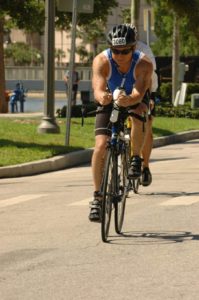
On my first bike after a couple of modifications
1. Buy an entry level road bike. This is usually an aluminum alloy frame. You don’t want a Wal-mart special, but you don’t need to start with the top of the line bike either.
2. Purchase a set of entry level pedals, cleats and shoes. The pedals usually come with the cleats and the bike shop will install them for you.
3. Purchase safety equipment. Biking shorts, and a helmet to start. I would also have a set of sunglasses as well. Not just to keep the sun out of your eyes, but it helps with the wind too. Make sure you also have at least one water bottle with a cage installed on your bike.
4. Get the bike fit for you. Have a certified bike fitter make those adjustments specifically for you.
5. Practice getting in and out of your cleats . Put your bike in a doorway, hold onto the frame and get in and get out of your cleats. Find the most comfortable side of the bike and then practice getting out of the cleats and putting your foot on the ground.
6. Take a short ride around your neighborhood and continue to practice getting in and out of your cleats. When seeing a stop or even a potential stop ahead practice just moving your heel just to the point where you unclip before stopping so you have a quick option that you can pull out of your clip to stop or return your heel to clip back in to keep going. Remember to always clip out and stand with the same foot first every time.
7. Understand your gears. While in that first ride, switch the gears on your right hand and find what lever takes you to a higher or easier gear, and which one brings you to a lower or harder gear.
8. Take your first long ride with friends and have some fun.
One last thing, you are going to fall. That is just the reality of it. You will get stuck in your cleats at some point and you will fall over, but it will be minimal. The trick is to accept it, get up brush yourself off, laugh at yourself, get back on your bike and have fun. It’s worth it I promise.
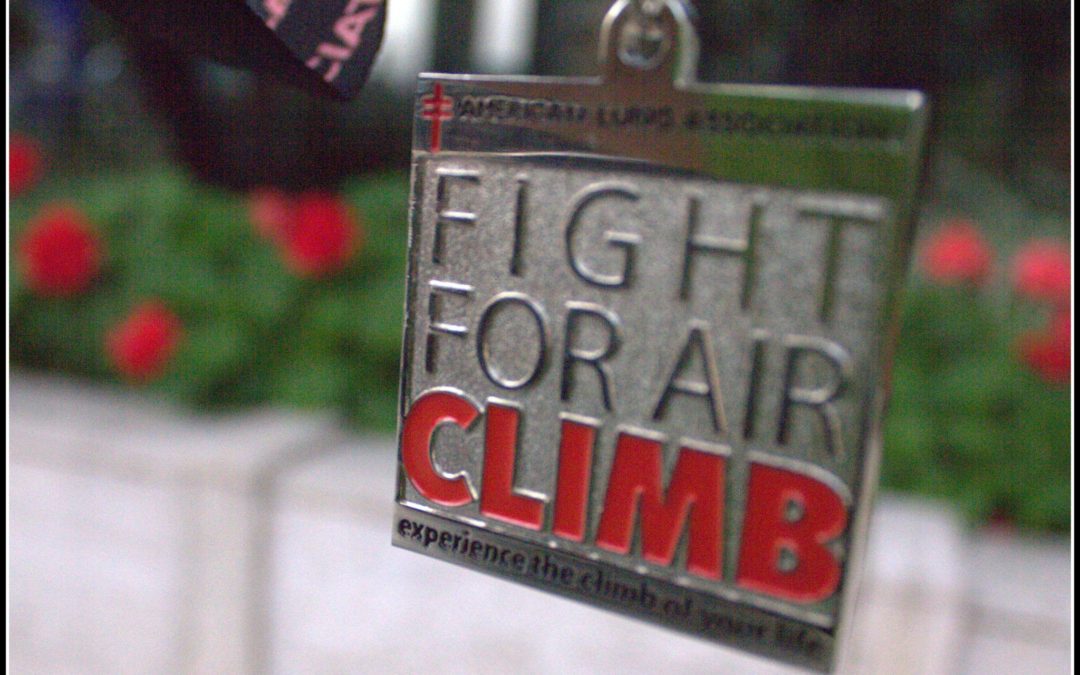
What a weekend! I raced with Team Foley Saturday during the Fight For Air Stair Climb in Tampa at the Bank of America building, then I did my first triathlon of the season at the HITS Ocala Olympic Triathlon. Needless to say come Monday morning I was a little stiff, but full of rigor because of what I accomplished.
Saturday morning the alarm went off at 5:30am which actually was about 45 minutes later than during the week. (WOO HOO! I got to sleep in.) I had no trouble jumping up, taking a quick shower to wake up, and heading into downtown Tampa for the Fight for Air Stair Climb. These stair climbs are sponsored by the American Lung Association and are held all over the country. The Tampa event consists of a team event, an individual event and a firefighter event. The Team Event, incorporates an undetermined amount of members on the team, and is scored with the top 3, lowest times. The members of teams, and athletes not members of teams, are entered into the individual event which incorporates the common age groups and is scored based on the individual’s performance. The firefighter event, is strictly for active firefighters sporting their full protective gear. Boots, pants, coat, helmet, tank and mask, while then racing up the 42 flights. It is an incredible site.
I have been a member of Team Foley under the leadership of Captain Lisa Jamison for the last couple of years.
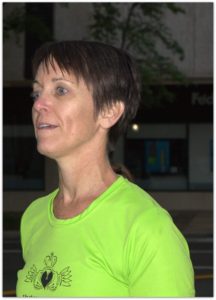
Fearless Leader
Lisa Jamison
John Foley was a good friend of hers whom passed due to lung cancer, so our team has always dedicated our performance to him. The last two years we finished first and won the team competition, but unfortunately a team named “7 Minutes of Pain” ended up winning, but we finished a close second.
The event starts with the normal registration and announcements outside the building and then the teams are brought in by their predetermined time, to the stairwell. The bibs we are given have timing chips built in and a couple of steps before the first set of stairs is a start mat with the finish mat at the top to capture the times. We arranged ourselves from fast to slow, so their would be very little passing that would cause a delay in any team member’s time or interrupted strategy. I was positioned right behind Eric Scola, a CrossFit instructor and friend who was in obvious excellent shape. He took off as I waited required 10 second gap in-between athletes before I started my journey to the top.
For such a short race, it feels like forever. There are different strategies to running the stairs. Last year I blasted up 15 flights, before my lungs decided they had enough and I had to slow down. This year I decided to take the same pace all the way up. I found a rhythm of pulling on the rails and double stepping almost the entire way. I did take a few single steps about 4 times during the duration of the race, but I mainly stuck with the double. It ended up working for me with a time of 7:22 which was just about the same as I did last year, but I felt better and recovered faster. In 2012, my lungs started really burning around floor 30 and it was very difficult to continue and it lasted almost 30 minutes after I completed the climb, but this year I ended up at the top feeling pretty good. That is, until I sat down. The burning sensation caught up with me as I was recovering in a small room at the top with a bottle of water. It was very uncomfortable. Thankfully they did not allow us to stay as long as we did in the past and shooed us back downstairs. With the fresh air, I ended up recovering in about 5 minutes from the moment I exited the building.
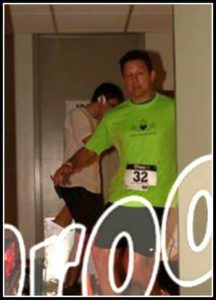
Finish
There is no ventilation in the stairwells or humidity for that matter and I believe after using maximum effort without regards to heart rate or respiration rate, it leads to that burning sensation for me.
After recovering an drinking some more water I found myself feeling really good. It is the longest 7 minutes of my year, and I am so happy I have the ability to fund raise and compete in this race for Lisa and Team Foley.

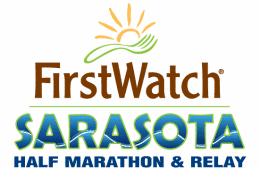
I am a little behind on posts, and now need to add three more due to being sent and then utilizing three new products during the race; the Hoka One One Biondi S2 running shoes, the Jaybird Sport Strap bluetooth headset, and Wrightsock Stride running socks. I will do my best to get those reviews completed as soon as possible, but for now let me tell you about my experience with the US Road Races Sarasota Half Marathon.
I learned a lesson first thing because I ended up running a tad bit late in the morning. The drive time to Sarasota usually is 45 minutes and I thought I was going to be fine until two miles from the race start. The traffic came to a dead stop. I drive a Mini Cooper Clubman, so while maneuverability is not an issue going over things like medians become either not possible, or the consequences may turn out to be expensive. I was stuck behind a tractor-trailer semi trick with my right lane blocked and a huge median to my left. No way out. After a while, of being a little stressed of missing the start, I noticed the median curb height had changed to regular curb height so I took the chance and allowed my little car to climb over it. Luckily I found an alternate route, and parking pretty fast, but a ways from the start, so involuntarily I sprinted a quick warm-up mile prior to the gun.
I could hear the National Anthem being sung as I was running to the start, which told me it was going to be tight making it, and of course there were close to 5000 runners, so I ended up starting in the 13 minute/mile corral. At first I was a little disappointed, but it gave me a little time to stretch and calm myself down. I usually start up near the front of the pack, and end up getting passed throughout the race, however this time it was me who was doing the passing.
Miles one and two ran along Tamiami Trail and over a bridge which wasn’t very steep, although it felt long, but it did allow for some recovery on the other side. Some coaches worry about their runners as they run downhill, but the form I teach really allows the ease of just letting the legs do what they will allowing for a nice recovery. Of course I also coach a way on the uphill that makes the effort feel a lot less as well, but that is for another time.
The 5k split ended up in a circle downtown and according to my split time, it wasn’t bad. 23:24, less than an 8 minute mile for the first three miles, I’ll take that. Miles four and five were back over the bridge and past the start/finish line. Unfortunately, my sock started slipping in the circle, so after mile 5 I actually had to stop, and take off my shoes so I could re-position my sock. I couldn’t believe it. Because I was product testing my shoes I did not put lock laces on, so I even had to untie and re-tie the laces. I think it was 3 minutes wasted. It wasn’t a huge amount of time, but it still irked me. I will talk more in my review of the socks.
After that it was just a lot of fun. I caught up with some friends along the way, Holly Tripp, Teresa Gadient, a couple of others and chatted and then continued on my way. It was a beautiful course that ran inside a nice residential area and then back to the finish. The view was not anything spectacular, but a decently scenic throughout the course. The weather held to mid 60’s throughout the morning, which is perfect for me.
The last couple of miles were back down Tamiami Trail and then turned back into the community center and into the finish shoot. I picked up the pace on the last couple of miles and actually had enough for a little sprint kick at the end, which I haven’t had in a while. I wish I could figure out what I did, that made that difference. It could have been the steel-cut oats I had that morning, or even a new natural supplement I started a month ago, but I definitely had a little more than I thought. This would have been a nice PR race, but my strategy was negative splits, and very conservative. Next half I’ll do it.
There is one thing to be said about starting in the back and passing people up versus getting passed. Positive/Negative reinforcement. It shouldn’t feel that way, but I believe I also had some energy build from passing everyone except for three whom passed me. Positive conditioning. Starting in the front and getting passed no matter what I tell myself, still has a negative effect on my semi-fragile ego. Do not get me wrong, I know my place. I have always preached strength before speed. I have stated over and over again I am not fast…yet, but I am a strong runner and at a comfortable pace I can run forever. Unfortunately, that pace is pretty slow right now.
I met up with Ben Mena, Nick Zivolich and some other athletes and, Beth(B.o.B) joined us a bit later after finishing herself. I will say the medal is huge and beautiful and athletes running in the other US Road Race Half Marathon series, receive an extra medal with the number of races they ran in the series. If the athlete competed in 2 of the series they received a 2 inch number 2, for 3 races a 3 inch and so on. I like the concept and those medals were gorgeous too. It may be something to ponder trying to complete next year.
That was the glorious morning of my St. Patrick’s Day. I cannot think of a better way I would’ve spent it.

In my post Goof Views and News #1 I again mentioned that swimming is my weakest event in the sport of Triathlon. I remember completing a bike workout with the A-Train and one of our athletes David Nardoski was complaining of how slow a swimmer he was. When we compared times, he was still 20% faster than I was or, am. (Just for your information, David did not one, not two, but FOUR Ironman triathlons last year, plus a couple 70.3s as well.)
I also mentioned that I enlisted the help of Brenton Ford from Effortless Swimming and his Swimprove program. If you are ready for a laugh here is the video I sent him for analysis.
[embedplusvideo height=”196″ width=”300″ border=”3px” standard=”http://www.youtube.com/v/6rCT_x5W5vY?fs=1″ vars=”ytid=6rCT_x5W5vY&width=300&height=196&start=&stop=&rs=w&hd=0&autoplay=0&react=0&chapters=¬es=” id=”ep4597″ /]
Interesting right? Can you see those ankles? How the heck am I supposed to move through the water with ankles that barely straighten past 90 degrees? Unfortunately, the video didn’t exactly have the best angles so Brenton wasn’t able to analyze it, so I am hopefully going to enlist the help of a friend to do some more recording. More videos are on the way. (Oh goodie, just what you wanted to see. More horrible swimming. Right?)
Yesterday, I completed the introductory lesson in the Swimprove Mastering Freestyle Program, which was 2000 meters of drills. While at first glance the drills seemed rudimentary, even for me, they helped tremendously.
The workout when like this:
At first glance it doesn’t look so bad does it? I didn’t think so either until I dug into it. It was the amount of kicking. As proof from the video, I do not have what any swimmer would call a strong kick, so it felt like forever for me to move from one wall to the other, but luckily that wasn’t the point of the drills. It was to learn balance. and that, ladies and gentlemen, is a lesson I learned. I finally felt what it was like to be able to have a steady plane toward the surface of the water without a lot of effort.
From the second set on, I put on a pair of Zoomers(short fins) so I could at least get through the workout in time for work, and with each set I felt myself feel the water a little more. Of course all the “feel” in the world didn’t keep me from zigzagging down the lane, at least while I was on my back, but my whole body was at least on the surface without dragging my legs, which is a huge issue for me.
By the time I turned over and was kicking on my side, and allowed my arm to dip below the surface about thirty degrees, I felt like I was really moving. I even had an epiphany about breathing because while on my side I was forced to exhale out and almost roll completely over to get a breath. I even started to relax a bit. The cool down, while still not effortless, was far more streamlined than when I first entered the water that workout.
I think Brenton might have something with his Swimprove program.
Stay tuned, boys and girls, for more highlights from my journey to a faster more efficient swim.
